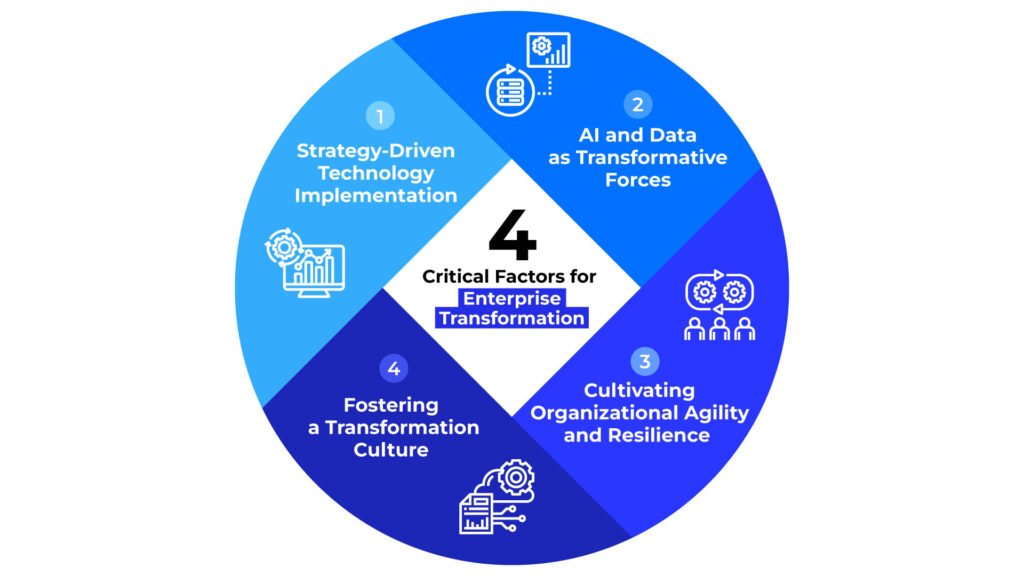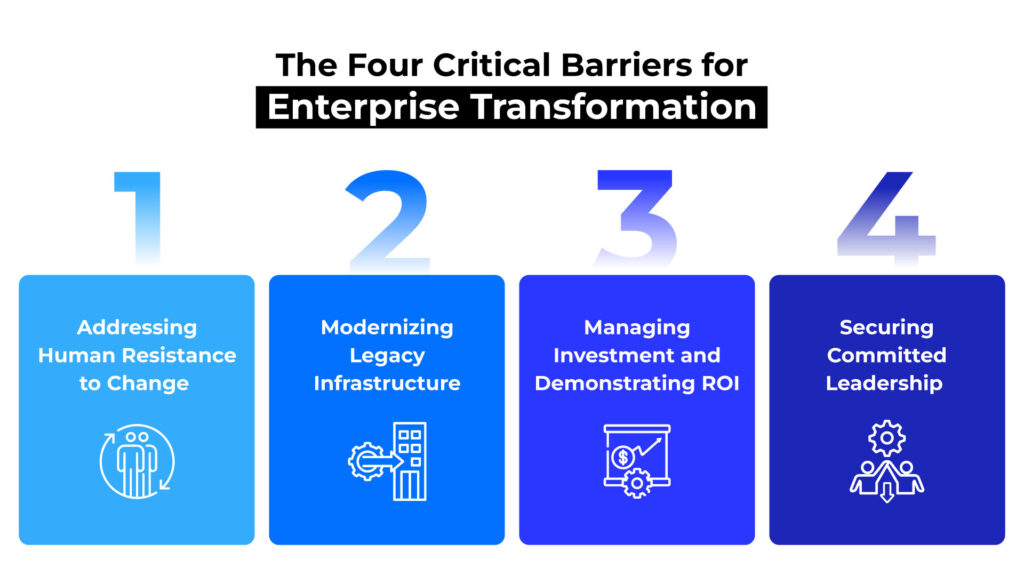The Imperative of Change
In today’s rapidly evolving business landscape, enterprise transformation isn’t merely an option—it’s a necessity. The stark reality? If your organization doesn’t transform, your competitors certainly will.
The most successful businesses of our era embrace enterprise transformation as their north star—implementing strategic, technology-driven initiatives that secure long-term competitive advantage. Meanwhile, organizations resistant to change find themselves falling behind.
The technological revolution—driven by Artificial Intelligence (AI), Cloud Computing, Automation, Advanced Data Analytics, and the Internet of Things (IoT)—is fundamentally reshaping business models across every industry. True adaptation transcends the simple implementation of new technologies—it demands a comprehensive reimagining of how business itself is conducted.

The Transformation Narrative: Success Stories and Cautionary Tales
The Price of Resistance: Kodak’s Downfall
History offers sobering lessons about the consequences of failing to adapt. The story of Kodak stands as perhaps the most compelling cautionary tale—once the undisputed global leader in photography, Kodak filed for bankruptcy in 2012. The tragic irony? Kodak engineers invented digital camera technology as early as 1975, yet the company’s unwavering commitment to traditional business models and entrenched organizational culture ultimately sealed its fate.
Transformation Champions: Netflix, Amazon, and Tesla
Netflix masterfully transformed itself from a DVD rental service into a global entertainment powerhouse. By pivoting to streaming and investing heavily in original content creation, Netflix didn’t merely adapt to changing market conditions—it redefined the entire entertainment industry. Netflix’s subscriber base grew from 21.5 million in 2011 to over 230 million in 2023 after shifting to streaming.
Amazon evolved from a modest online bookstore into an e-commerce and cloud computing giant. Guided by its “Customer Obsession” principle, Amazon’s continuous strategic adaptation has created one of the world’s most valuable companies. Amazon Web Services (AWS) contributed over 70% of Amazon’s operating profit in 2022, proving the power of diversification in transformation.
The critical question: Which trajectory is your organization following?
What Is Enterprise Transformation?
At its essence, enterprise transformation elevates organizational effectiveness through the strategic deployment of technology aligned precisely with business objectives. This creates powerful capabilities in three critical dimensions:
✅ Business Agility – The capacity to rapidly adapt to changing market conditions.
✅ Operational Excellence – Streamlined processes that maximize efficiency and minimize waste.
✅ Customer-Centric Innovation – Developing solutions that anticipate and exceed customer expectations.
Enterprise transformation extends far beyond merely integrating new technologies into existing frameworks. It represents a fundamental reimagining of business models, processes, and organizational culture to create sustainable competitive advantages.
The Four Pillars of Successful Enterprise Transformation

1. Strategy-Driven Technology Implementation
Enterprise transformation must begin with clearly articulated business objectives and a coherent strategy. Only then can technology serve as an enabler rather than an end in itself. The most successful transformations align technological capabilities precisely with strategic business goals.
2. AI and Data as Transformative Forces
AI-led integrated services empower organizations to anticipate market trends, generate actionable insights, and make data-driven decisions with unprecedented precision. When properly leveraged, AI and advanced analytics become the engines driving organizational transformation.
3. Cultivating Organizational Agility and Resilience
In an era of constant disruption, organizations must develop the capacity to navigate change efficiently. This requires creating flexible organizational structures, adaptive decision-making processes, and resilient operational models.
4. Fostering a Transformation Culture
Technology alone cannot drive meaningful change. Employees and processes must evolve in parallel, embracing digital-first thinking and data-driven decision-making as foundational principles. Cultural transformation underpins all technological advancement.
Overcoming the Four Critical Barriers to Enterprise Transformation

Despite the benefits, transformation is rarely a smooth journey. Here’s how organizations can tackle four key challenges:
1. Addressing Human Resistance to Change
The most significant impediment to enterprise transformation often isn’t technological—it’s human. While AI, automation, and advanced analytics promise enhanced efficiency, they simultaneously generate workforce anxiety about potential displacement, creating resistance to implementation.
Strategic Response: Organizations must cultivate a learning culture that emphasizes continuous skill development. Leadership must clearly communicate that technology aims to augment human capabilities rather than replace them, focusing on how technological advancement creates new opportunities for employees to deliver higher-value contributions.
2. Modernizing Legacy Infrastructure
Many organizations remain tethered to outdated IT systems designed for earlier business paradigms. These legacy systems create substantial barriers to implementing transformative technologies like AI, cloud computing, and data-driven systems.
Strategic Response: Organizations should develop methodical modernization roadmaps, beginning with comprehensive value assessments. Cloud computing and hybrid solutions offer particularly effective approaches to bridging traditional and contemporary systems while minimizing operational disruption.
3. Managing Investment and Demonstrating ROI
Enterprise-level transformation requires significant capital investment, yet returns may not materialize immediately. This delayed gratification can create resistance among stakeholders expecting rapid results.
Strategic Response:
- Identify and prioritize “quick win” initiatives that deliver measurable short-term value.
- Implement robust data-driven frameworks to analyze investment efficiency across diverse organizational functions.
- Structure transformation as a phased journey rather than a single massive undertaking.
4. Securing Committed Leadership
Enterprise transformation cannot succeed without unwavering leadership commitment. When executive support wavers, transformation initiatives inevitably falter.
Strategic Response:
- Leadership must articulate a compelling transformation vision and position it as a long-term strategic imperative.
- Establish clear accountability across all organizational levels.
- Design incentive structures that motivate both leaders and employees to actively drive change.
The Path Forward
The current AI revolution represents merely the opening chapter of a much larger business transformation story. Future technological disruptions will continue reshaping industries at an accelerating pace, demanding organizations capable of continuous evolution.
The organizations that thrive in this new era won’t necessarily be those with the most advanced technology—they’ll be those most adept at strategically orchestrating change through thoughtful enterprise transformation.
Connect with Bluebik
Bluebik believes that successful transformation emerges from the strategic integration of cutting-edge technology with sound business principles. As a leading regional enterprise transformation consultancy, we partner with organizations to drive meaningful transformation through our comprehensive service portfolio, spanning Big Data & AI, Cybersecurity, Digital Excellence, ERP Implementation, Management Consulting, and Strategic PMO.
Enterprise transformation is more than an upgrade—it’s a necessity for long-term success. Bluebik combines strategy and technology to help your organization adapt, compete, and thrive.
📧 Email: [email protected]
📞 Phone: 02-636-7011










![Thumbnail [Post Event] HOW](https://bluebik.com/wp-content/uploads/2025/12/Thumbnail-Post-Event-HOW.png)

